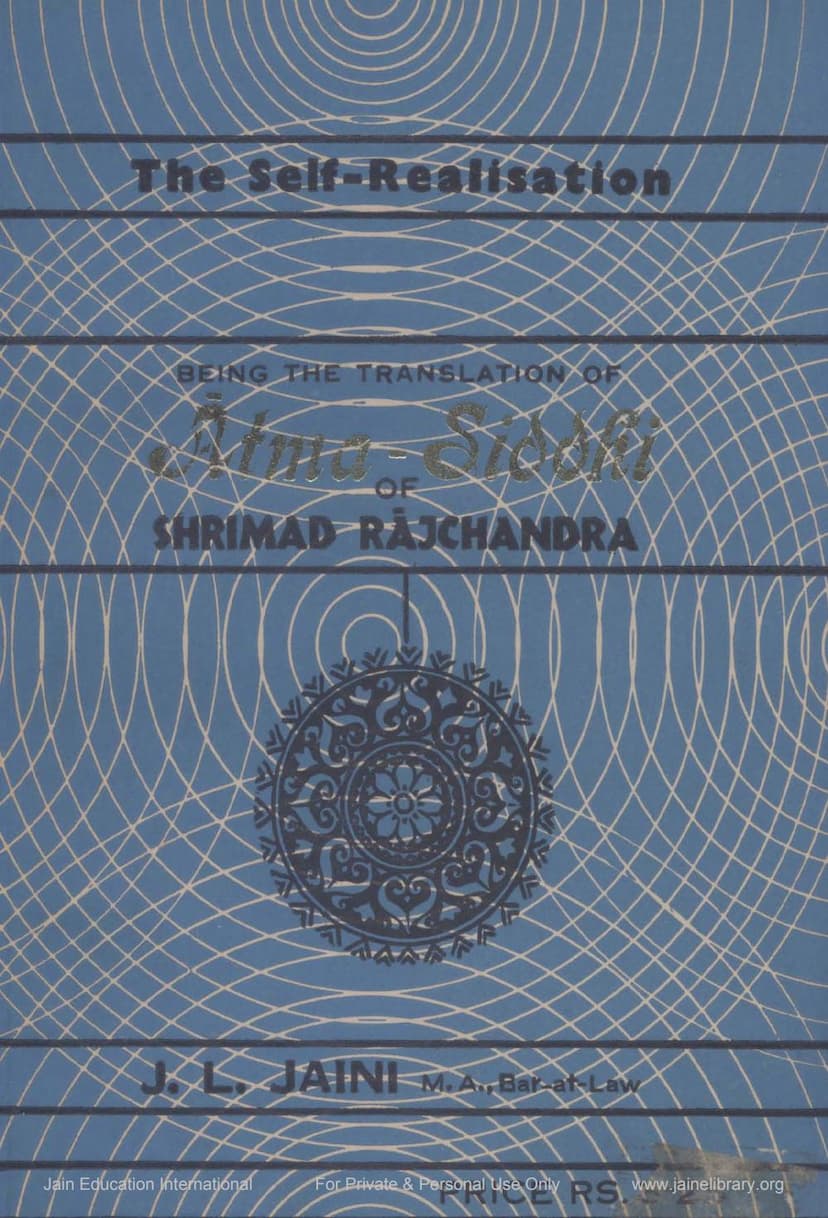Atma Siddhi
Added to library: September 1, 2025

Summary
Here is a comprehensive summary of the Jain text "Atma Siddhi" by Shrimad Rajchandra, translated by J. L. Jaini:
"Atma Siddhi," meaning "Self-Realization," is a profound Jain spiritual text authored by Shrimad Rajchandra, a revered saint-philosopher of the modern era. Translated into English with an insightful introduction by Rai Bahadur J. L. Jaini, the book aims to guide seekers towards true spiritual understanding and liberation.
Core Message and Purpose:
The central theme of "Atma Siddhi" is the realization of the true nature of the soul. Shrimad Rajchandra emphasizes that true happiness and liberation can only be achieved through self-knowledge. The book critiques superficial religiosity, advocating for a path that integrates right belief, right knowledge, and right conduct. It serves as a guide to dispel ignorance and illusion, leading the aspirant towards the ultimate goal of self-realization, which is synonymous with liberation (Moksha).
Key Concepts and Structure:
The book is structured around a dialogue between a True Teacher and a pupil, where the pupil raises doubts and the Teacher provides clear and reasoned answers. The core of the teaching is presented through six fundamental propositions (Shaloka), which form the essence of the spiritual path:
- The Soul is (Atma Asti): The existence of the soul is affirmed, differentiating it from the non-living and establishing its unique consciousness. The Teacher uses analogies like the eye seeing itself to illustrate the soul's self-aware nature.
- The Soul is Eternal (Atma Nitya Asti): The soul is presented as indestructible and ever-present, existing across all three times (past, present, and future). This eternity is supported by the law of cause and effect, and the continuity of experiences that transcend a single lifetime.
- The Soul is the Doer of Actions (Karma): The soul is identified as the agent responsible for its actions, whether good or bad. While the body and mind are instruments, the conscious volition and discrimination originate from the soul.
- The Soul is the Enjoyer of the Fruits of Karmas: As the doer, the soul also experiences the consequences of its actions. This is presented as a natural law of cause and effect, evident in the disparities of fortune and suffering observed in life.
- There is Liberation (Moksha Asti): The possibility of liberation from the cycle of birth, death, and suffering is asserted. This liberation is the soul's return to its pure, inherent state, free from the bondage of karmas.
- There is Means of Liberation (Moksha Upaya Asti): The book outlines the path and methods to achieve liberation. This path involves understanding the six propositions, cultivating virtues, and following the guidance of a True Teacher.
Critique of Superficial Practices:
Shrimad Rajchandra strongly criticizes:
- Ritualism: Adherence to external religious rites and ceremonies without inner understanding or transformation is deemed futile.
- Barren Knowledge: Possessing theoretical knowledge without practical application or inner realization is also criticized as insufficient and misleading.
- Bigotry and Fanaticism: The text condemns those who cling to their own narrow views, traditions, or teachers without genuine inquiry or an open mind, especially when they ignore the path of true knowledge and inner transformation.
The Role of the True Teacher:
The book places immense importance on the Living True Teacher (Sadguru). The Teacher is seen as essential for guiding the seeker, dispelling doubts, and providing the direct experience and understanding necessary for spiritual progress. Reverence and obedience to the True Teacher are presented as crucial elements of the path.
The Path to Liberation:
The means of liberation are expounded through:
- Right Belief (Samyak Darshan): This is the initial stage of understanding the true nature of reality, attained through the guidance of the Teacher.
- Right Knowledge (Samyak Gyan): This involves a deeper, experiential understanding of the soul and the universe.
- Right Conduct (Samyak Charitra): This is the practical application of right belief and knowledge in daily life, characterized by ethical behavior, control of passions, non-attachment, and compassion.
The text details how the eradication of passions like anger, pride, deceit, and greed, through virtues like forgiveness, humility, truthfulness, and non-attachment, leads to the destruction of karmic bondage.
The Pupil's Journey:
The pupil's journey in the text illustrates the seeker's initial confusion and doubts, their earnest desire for truth, and their eventual enlightenment and liberation through the Teacher's wisdom. The dialogue format makes the complex philosophical concepts accessible and relatable.
Mahatma Gandhi's Endorsement:
The book features quotes from Mahatma Gandhi, who deeply admired Shrimad Rajchandra, stating that Rajchandra's influence on him was even greater than that of Tolstoy and Ruskin. Gandhi recognized Rajchandra's profound knowledge, detachment, devotion, and his ability to derive maximum benefit from any situation.
In essence, "Atma Siddhi" offers a timeless and practical roadmap for spiritual liberation. It emphasizes that true religiosity lies not in outward rituals or intellectual knowledge alone, but in the inner transformation of the soul through self-awareness, virtuous living, and the guidance of a qualified spiritual master. It is a concise yet comprehensive exposition of Jain philosophy aimed at awakening the soul to its true, eternal, and blissful nature.